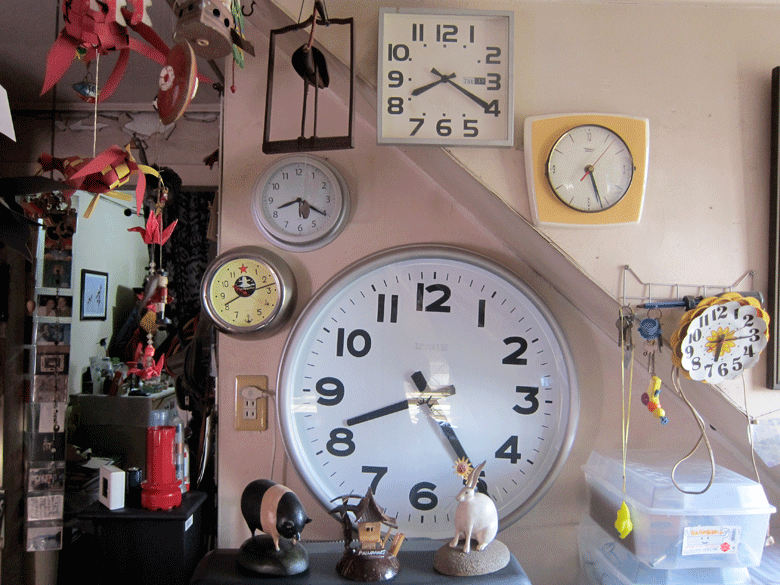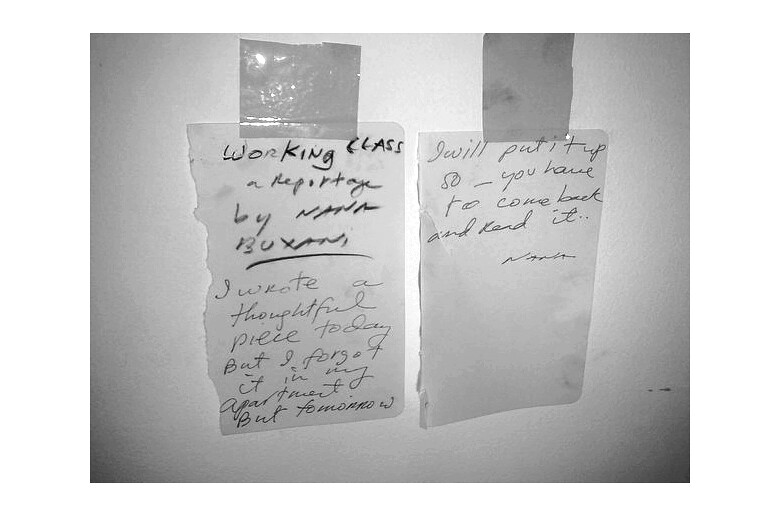
They're not here but the photographs in Working Class: A Reportage by Nana Buxani are moving, depressing, heartbreaking. We were there last Friday to give her a hug. Go see them at Manila Collective in Cubao X--so you can also read what she wrote.
The photographer will have a talk on Wednesday, July 28, 8pm in the same venue.
Friday, July 23, 2010
NANA'S NOTE ] Because she forgot to bring her statement on opening night
OBSESSED MUCH? ] Think you already live and breathe cinema? Here, meet SOFIA

In 1993, a group of professionals who were engaged in some form of archiving organized the Society of Film Archivists, the original name of SOFIA. Without funds, much less its own office and archiving facilities, the group members were fueled simply by their passion for film and their resolve to preserve the film heritage of the country.
SOFIA identified specific needs for the retrieval and restoration of endangered films. It also organized short-term training workshops in preservation and collection management, and offered to advice various institutions in their archiving programs. With the assistance coming from the National Commission for the Culture and the Arts, SOFIA was able to program the restoration of some landmark films, including the first film produced by LVN in 1938-1939 and some key films by major filmmakers like Gerardo de Leon, Lamberto Avellana, Lino Brocka and Ishmael Bernal.
Philippine cinema is almost a hundred years young. In Asia, Filipino filmmakers were among the pioneers, its film industry among the largest in the world in terms of output for a good number of decades.
Of the roughly 8,000 plus full-length films produced in the first century of local cinema, many have been irretrievably lost, rendering moot anyone's judgment as to their artistic merits. Just as bad are the forgotten status of numerous talented filmmakers from way back, whose best works and once promising careers have fallen off the radar film history.
This film series, called Overlooked, Underrated, aims to re-assess certain films and filmmakers, by taking a second look at their unjustly neglected bodies of work, and even restore a few reputations in the process. This will help to expand the repertoire of Philippine cinema, by going beyond the programming of the usual auteurs and masterpiece titles. There will be much to discover, and rediscover, by rounding up not the usual suspects.
For now, the initial batch of films/filmmakers will be limited to six. As more "lost" and neglected films come to the surface from here and other parts of the world, this film series will continue to run, without an expiry date. Happy re-viewing!
Thursday, July 22, 2010
BERLIN BOUND ] Artworks to be raffled off in fundraising to help send artists to Freies
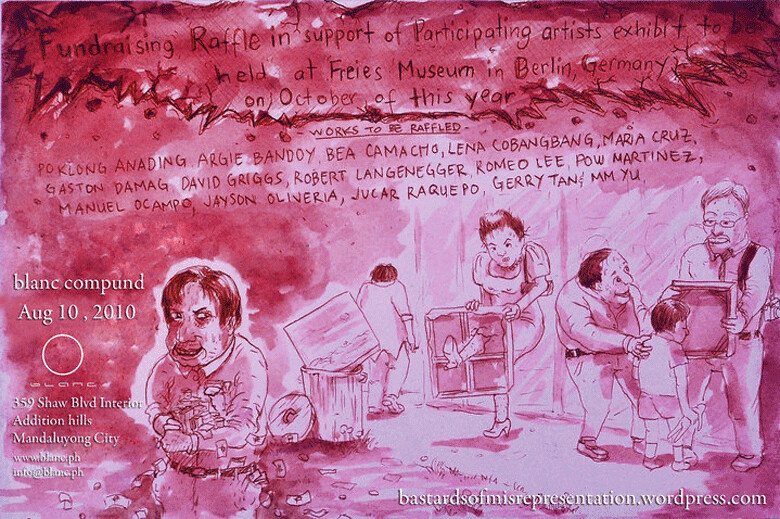
On August 10, 6pm at Blanc in Shaw Boulevard. 30 artworks from Argie Bandoy, Poklong Anading, Bea Camacho, Lena Cobangbang, Maria Cruz, Pow Martinez, Robert Langenegger, David Griggs, Romeo Lee, Jayson Oliveria, Jucar Raquepo, Gaston Damag, Gerry Tan, MM Yu and Manuel ocampo will be raffled off.
To buy or reserve raffle tickets email info@blanc.ph or lcobangbang@yahoo.com. This is to raise funds in support of the participating artists who will show at the Freies Museum is Berlin in October.
CLOTHES ENCOUNTER ] Robert Alejandro sketches from The Sartorialist
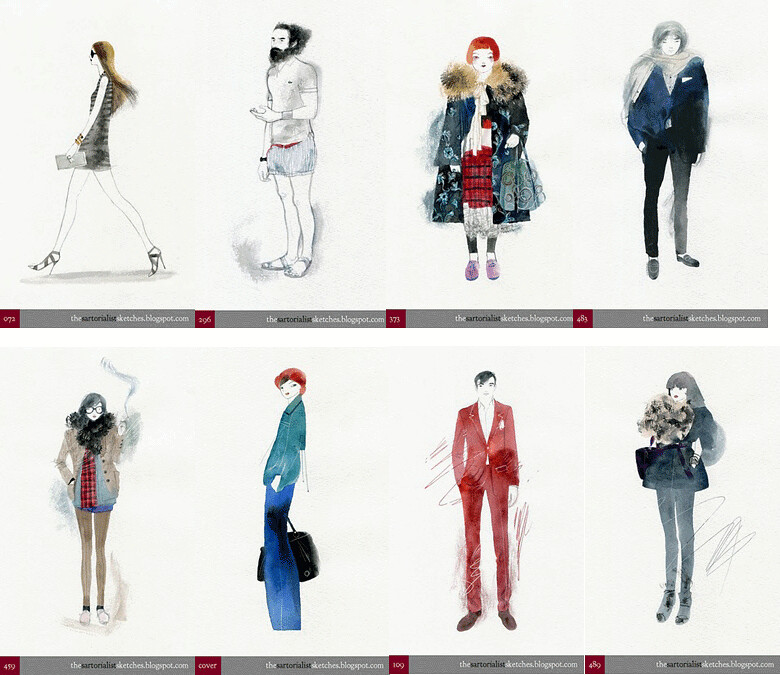
"I never heard of the website "The Sartorialist" - not until I saw the book at a bookstore. I didn't want to buy the book - I already made purchases and my bag was extremely heavy. But then, I loved the photographs, I loved how the people looked in the photographs and I thought it would be such a joy to draw them. Here are the sketches I've made and sure enough, it is a joy to draw and sketch these wonderful people photographed by Scott Schuman.
"If you get the chance, do take a look at this book, "The Sartorialist". The fashion sense of some people are AMAZING! I love it when someone isn't afraid of color, texture, being noticed or stared at!
"I think I'm SO fashion backward. My closet is full of black, brown, gray and more gray. I wonder whether I'll ever get over the fear of people noticing me.
"I don't dress well and I know it (my mom used to complain about it but she has given up on me). In one word, I dress sloppy. But this book, the Sartorialist has made me think, that I should do better. I should take better care of myself. I should dress better. I especially like the photographs of mature men who make an extra effort in looking real sharp and real cool. I think, I'd love to grow old this way."
"Have I made an effort? Sometimes I wear a hat - and that is already a big thing for me."
For more of Robert's sketches of people from The Sartorialist, click here.
Wednesday, July 14, 2010
BRING YOUR ERMATS ] Or just bring a drink. The Living Room screens Tisoy

Nonoy Marcelo by Ishmael Bernal produced by Nora Aunor. Enough said.*
Tomorrow, July 15, Thursday at 8:30pm, The Living Room will be screening Tisoy. Bring a bottle or something to munch on. The Living Room is Unit 24, North Syquia Apartments, 1991 MH del Pilar, Malate, Manila.
*But if you want to read more about Nonoy Marcelo, and a little about Tisoy the comic strip, Joan Orendain wrote this piece on him following his death in 2002.
THIS WEEKEND AT NOVA ] William Gaudinez on his explorations on Philippine folk traditions

"Folk Art in the Philippines represents diversity on various materials such as Philippine hardwood, capiz, mother of pearl, carabao bone, carabao horn, etc. Folk artisans re-create church retablos, pillars, furniture, and vestments that even if they lack formal art training, have never ceased to amaze me. As a neo-folk artist, I am fascinated with the works of these unknown artisans, that has encouraged me to find experimental, innovative ways to make my own interpretations while focusing on the traditional methods such as woodcarving, inlaying, incising, and paintings which I have adapted as my personal quest for identity and aesthetic direction through researching the works of the folk artisans of Bohol, and the indigenous works of the Bukidnons, Tausugs, Maranaos, and of the North such as the Ifugaos and Kalingas. 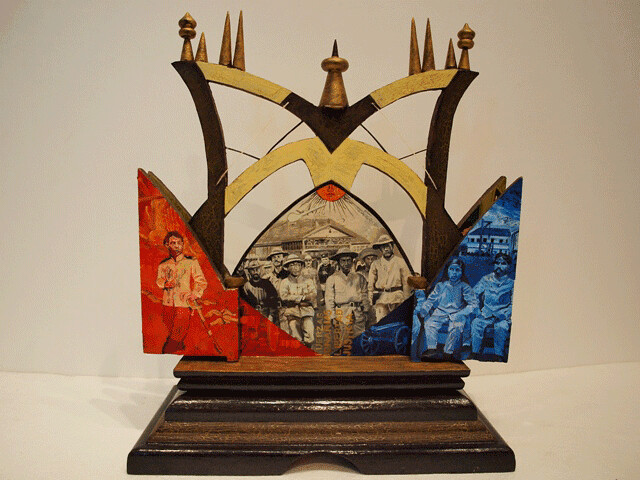
"In my own small way, I’m striving to present a timeline of certain periods of our ruch cultural heritage, history and lessons based on the pre-Hispanic period up to the time of colonization by Spain and America. I have incorporated bits and pieces of our folk beliefs and customs such as the role of the stars in harvesting, planting, fishing, and the prominence of the phases of the moon and the stars/galaxies in our day to day existence. I’m also keenly interested in presenting contemporary interpretations of the retablos and urnas fused with inlaid materials as vehicles to present these timelines and also show ironies on history’s bitter twists and turns."
William Gaudinez's show Alay Sa Lemuria runs from July 17 to August 4, 2010 at NOVA Gallery, Warehouse 12A, La Fuerza Compound, 2241 Don Chino Roces Ave., Makati City. All images by William Gaudinez courtesy of Nova Gallery.
Friday, July 9, 2010
SEVEN ON SIXTH ] The 7 reasons why we're going to Cinemalaya this week
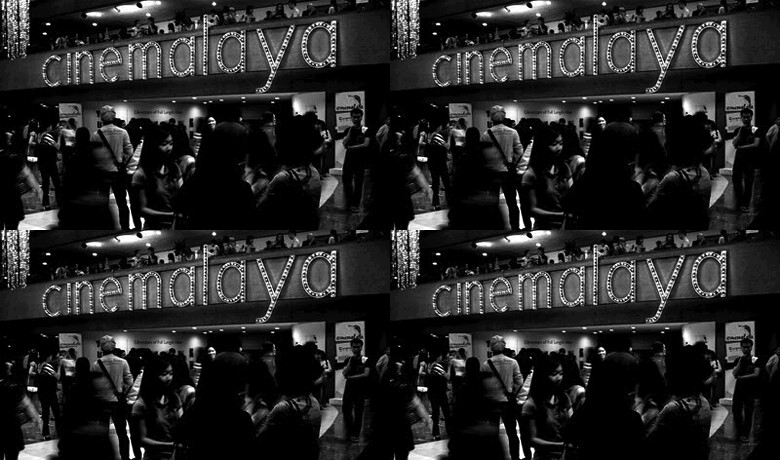 Photo from this website.
Photo from this website.
1 Because we want to see The Cinema of Celso Ad Castillo, a documentary on the director's life by Ron Bryant, the indie director who gave us that underrated and memorable Cinemalaya entry from 2006 called Rotonda (which also starred Castillo). But we're watching, of course, because we are Celso Kid fans. From the bits we saw, big names from local cinema (Ricky Lee, Peque Gallaga, Mel Chionglo et al) discuss his contributions to Philippine film history, take us back to that momentous and controversial Metro Manila Film Festival in 1977 where Da Kid's Burlesk Queen won all, if not most, of the awards. Castillo, who was once touted local cinema's enfant terrible, gave us such unforgettable film images as the wet T-shirt catfights involving Elizabeth Oropesa and several other kamisa-clad women, the unbelievably beautiful young Gloria Diaz riding a horse on the beach, and the gorgeous vision of a shirtless Vic Vargas---and that's just from Ang Pinakamagandang Hayop Sa Balat ng Lupa. Da Kid also gave us the insanely passionate Tag-ulan sa Tag-araw, the weird and poetic Pagputi ng Uwak, Pag-itim ng Tagak, and, well, Virgin People. Tipiti-pitim-tipitim, anyone?
2 Because Mario O Hara has a film. Its called Ang Paglilitis Kay Andres Bonifacio. We're discouraged by the title, and encouraged to watch only because he gave us Tatlong Taong Walang Diyos and that other film with Tatlo and Nora Aunor in it, a personal favorite, Tatlong Ina, Isang Anak.
3 Because they’re screening the good films we’ve missed last year: Engkuwentro, Last Supper #3, Ang Panggagahasa Kay Fe, Colorum, and, yes, Here Comes the Bride. How do we know they're good? Because our friends said so--and our friends are the biggest snobs.
4 Because they’re showing all 20 shorts that comprise the ANC pre-election project Ambisyon2010, about 18 of which are surprisingly good. Our favorites: the amazingly cool and exhilarating Ayos Ka by Brillante Mendoza, the heartbreaking Lupang Hinarang by Ditsi Carolino and the charmingly simple Di Ako Makatulog Dahil Wala Ka Sa Tabi Ko by Jade Castro.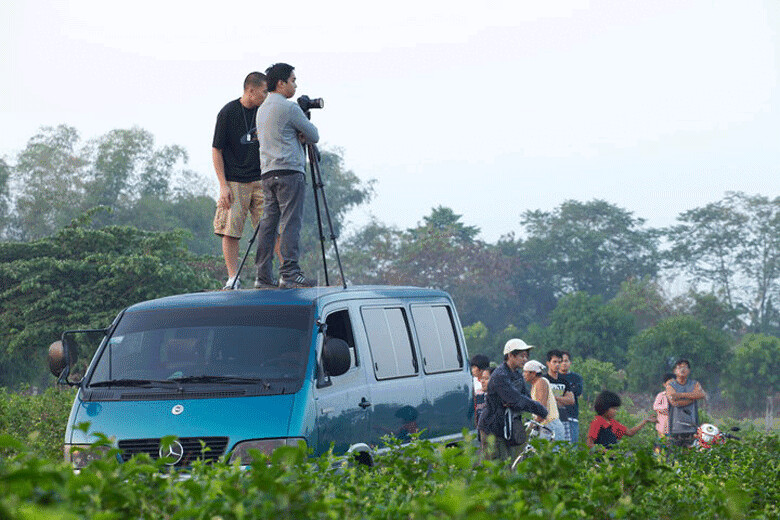 Francis Pasion shoots from the top of a sampaguita plantation.
Francis Pasion shoots from the top of a sampaguita plantation.
5 Because an insider who's read the scripts have given us the titles to watch out for. From the Directors’ Showcase, Two Funerals (screenplay by Eric Ramos), Sigwa (Boni Ilagan) and Donor (Mark Meily). And from the New Breed category: Limbunan (Gutierrez Mangansakan II), The Leaving (Ian Lorenos), Sampaguita (Francis Xavier Pasion) and Si Techi, Si Technoboy at si JuanaB (Art Katipunan).
6 Because if all else fails, there is the always dependable sweet spaghetti in the CCP cafeteria. So hindi ka pa rin uuwing luhaan.
7 Because this is that one week, well 10 days, in a year where the entire CCP comes alive and it just feels good to be around all that energy from film workers and film fans who are discussing movies and not, thanks heavens, show biz.
For more information on the 6th Cinemalaya Independent Film Festival and Competition, visit their website and Facebook page.
CUBAO NEXT ] Jake Verzosa serves muffins, espresso and real life in Manila Collective

It’s been awhile since we last ventured into Cubao X, and it’s nice to know there have been movements within its artsy, endearingly scruffy enclave—despite our long absence (Jejeje). The whimsical furniture store Heima has opened its second floor to serve as its manlier showroom. Right across it, Mogwai has expanded its ground level space to include the area that the gallery Blacksoup Project used to occupy. And then, most recently, there’s photographer Jake Verzosa’s café taking over the space of the hip curio store Vintage Pop.
Jake’s space, which is also a gallery, is called Manila Collective Photospace + Café. It is a small white box that, like most of the artist-run establishments in the Cubao X cluster, has a cool, homey, DIY feel to it. The space opened last May with an exhibition of Jake’s photographs of last January’s Feast of the Black Nazarene. Jake has been devotedly covering the prusisyon for the past six years, but this year decided to use a stereo camera. Hence, the 3D glasses provided the guests during opening night (Forgive our cluelessness, but we just checked out the photos in the website using a pair of 3D glasses we found lying around in the office—-pretty cool.) 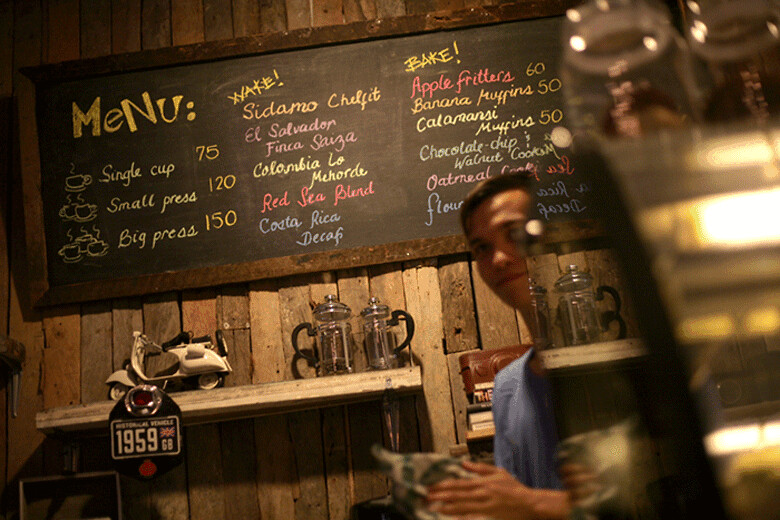
Next to grace its walls are the journalistic photographs of Nana Buxani, depicting working class life. July 17 and August 14 are the last of the four Saturdays that renowned documentary photographer Alex Baluyut is holding master classes on documentary photography.
For more information on Manila Collective, it's all in their website.Photographs courtesy of Jake Verzosa.
Wednesday, July 7, 2010
JUSTIN TIME ] Mark Salvatus speaks Bieberish
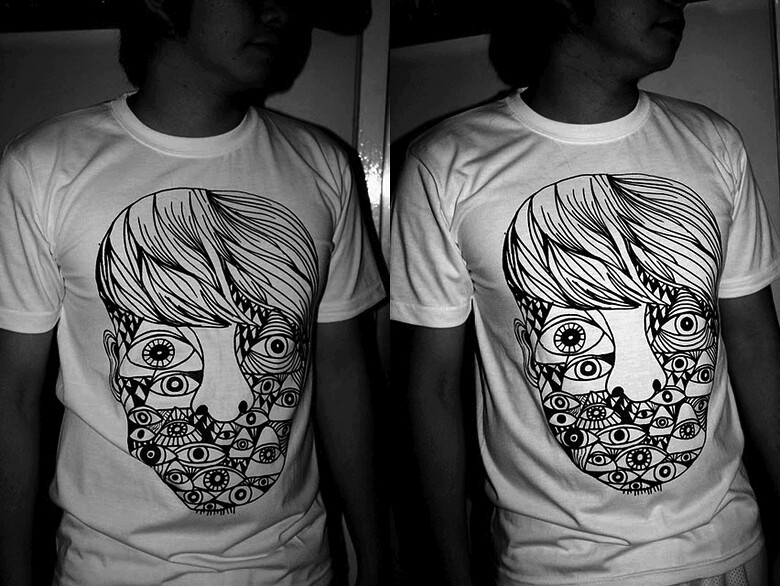
In his latest design for his Boy Agimat Boutique, the artist Mark Salvatus, using his favorite homegrown magic charm emblem, gives Justin Bieber more than enough peepers so that the twink popstar doesn't keep brushing off his stupid bangs. Babeh, babeh, oh.
Available soon in black, white, red, brown, green, and yellow gold.
Tuesday, July 6, 2010
BRANCHING OUT ] Sound designer Corinne de San Jose's fine art photography

What's with the fascination for dead trees?
To be honest hindi ko na rin alam. Medyo weird na nga eh. It probably started when I was a kid and I wanted to learn how to draw, so my parents bought me a drawing book. In the first few chapters, the book teaches you how to draw a silhouette of a dead tree. It was so easy to draw. I’d get lost drawing branches and twigs. Medyo hypnotic. And actually, I never finished the book so for the longest time it was the only thing I could draw. And ever since, every time I see a dead tree, i have to look. It pops out to me. And then i picked up photography and whenever i see one i have to take a picture.
Are these new images, or images taken over a long period of time? When did you start taking photographs of these trees? Where are they located?
The large prints (there are five), the ones taken at night, were taken early 2009. I started working on this series during a class I took at Silverlens under Isa [Lorenzo, the photographer, and owner of Silverlens]. Then I set it aside muna and started working on my first show. It felt unfinished pa. After my show, I showed them to Rach [Rachel Rillo, who is also a photographer and Isa's partner at Silverlens] and started shooting the rest na.
When I was shooting I had these self-imposed rules. And one would be that I have to shoot within Metro Manila lang. I wanted to look for these trees where it wasn’t so easy finding them. I would’ve had more trees to choose from if I allowed myself to shoot out of the city but it felt important to me to look for them here. So 'yon. Parks, villages, sa tabi ng daan. Basta within manila.
How did you get into photography?
In college. We were required to take three units of photography for Comm Arts. I loved my first photography class right away! I think I ended up taking 20 plus units in photography/photography-related electives. Hindi pa kasi uso sa La Salle ang photography majors non.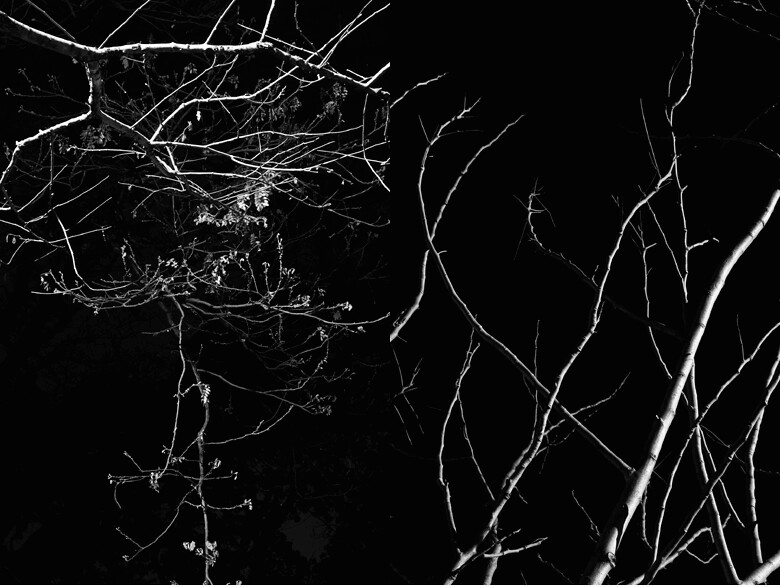
Do you remember the first photographs you took? What were they like, and what were they about?
I remember digging up my dad’s old rangefinder with my sister when i was about 12 or 13, tapos we shot black and white photos of each other from our bedroom. We used aluminum foil as a reflector. Ang pangit ng photos so we put back the camera in its hiding place. In college, it was a portrait of a friend in different lighting situations, as a lighting exercise for class.
You recently had a show before this, what was that one about?
The title of the show was It All Goes Slo-mo. The short answer is, I intended to shoot the view from my window, but I ended up shooting just my window. For the long answer, here’s a link to the work with the artist statement.
What camera do you use? And did you use film for these photographs? And did you develop them yourself?
I use my Canon 40d most of the time, lalo na for advertising/product shots etc. For this series, I used that, and a film camera, a Rolleiflex 3.5f. I did not develop the film myself, i brought it to a lab. The last time I developed my own roll was mga four years ago na.
How do you begin your day?
Go online tapos a cigarette and coffee.
And how do you end it?
A cigarette ulit.
Who are your influences in photography?
I love looking at old black and white photos of the masters. I can’t say I like one person more than anyone. Been looking at works of Siskind and Szarkowski a lot lately. (And of course there’s Ansel Adams, but that’s like the equivalent of a beauty queen saying she wants world peace. Plus, bumababa ang self esteem ko after looking at his stuff.)
Corinne de San Jose worked as an audio engineer for many years, and did the sound design for the acclaimed independent films Endo and Baby Angelo. Corinne's show, Some Die Young and Some Die Old, opens tomorrow evening at Silverlens Gallery in Pasong Tamo Extension.
All images by Corinne de San Jose, courtesy of Silverlens.
Sunday, July 4, 2010
WHERE WERE YOU? ] Manila Circa '46 from the lens of Teodulo Protomartir
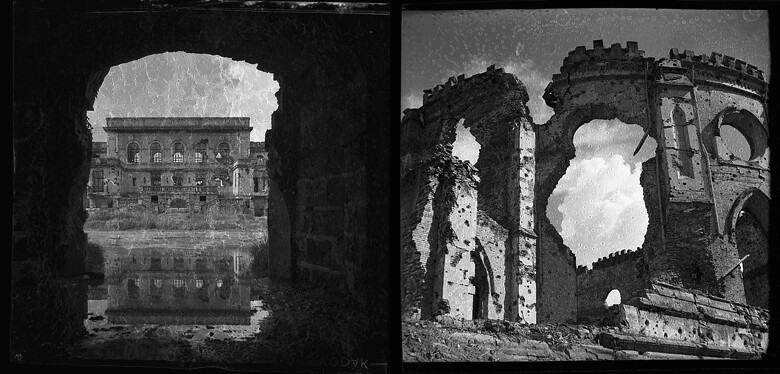 The Commerce Chamber of the Philippines and (right) Sto Domingo Church ruins.
The Commerce Chamber of the Philippines and (right) Sto Domingo Church ruins.
Teodulo Protomartir was there in 1946 when the Americans gave the Philippines its independence. On July 4, he witnessed the birth of the Philippine Republic.
Protomartir, the photographer who first brought the 35mm format to the Philippines and actively promoted photography through his photo club and radio show, shows us a monumental event in Philippine history and the Manila that enveloped it. Considered as the Father of Philippine photography, Protomartir captured the city in ruins from the Second World War, its battle wounds and its restoration – scenes we thought only survived in memory. He captures post-war Manila’s architecture and landscape, with Filipinos going about their daily business in familiar places such as Intramuros, Luneta, Ermita and Quiapo as well as in buildings and bridges that are no longer, including the old Sto. Domingo Church, which is one of the six Churches that once stood in Spanish Intramuros. For almost four centuries there stood the home of Our Lady of La Naval before it was bombed in 1941.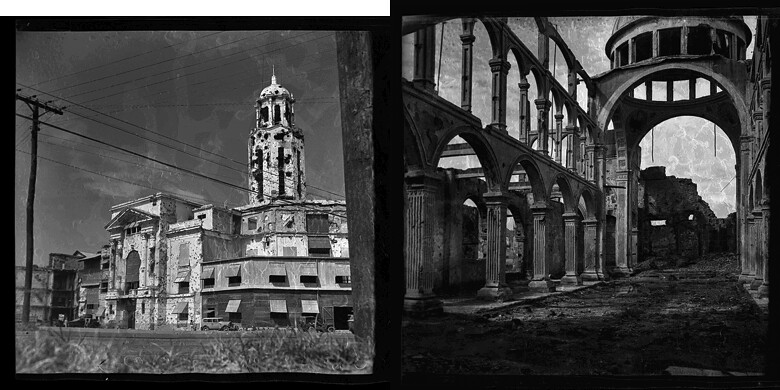 Manila City Hall Building from Arroceros cor. Concepcion and (right)interior of Lourdes Church.
Manila City Hall Building from Arroceros cor. Concepcion and (right)interior of Lourdes Church.
Beyond historical evidence, the significance of Protomartir’s images is meaningful. Protomartir hands to the Filipino people cultural treasures that should remain part of Filipino consciousness and memory. Sixty-four years later, we celebrate Protomartir because through him we were there too.
The Images of Being There 1946: The Legacy of Teodulo Protomartir were printed by Billy Mondoñedo.
For inquiries, contact Silverlens Gallery at 2/F YMC Bldg. II, 2320 Pasong Tamo Ext., Makati, 816-0044, 0917-5874011, or manage@silverlensphoto.com.
Images: Teodulo Protomartir, courtesy of Silverlens Gallery.
Monday, April 5, 2010
THE ANNIV ] A year's wealth of quips, epiphanies, inspiration and damn smart advice
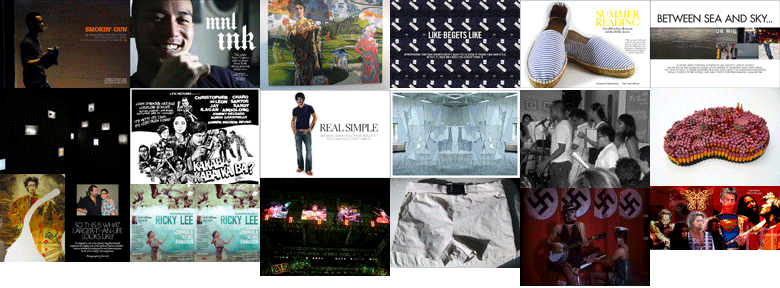
From the birth of an idea to how to write a eulogy. We've covered so much, and yet still so little, the past 12 months of this blogzine's existence. Here, we gather the gems that we've harvested. Browsing through a year's worth of posts, we feel deeply proud about the names who have contributed one way or another to this humble endeavor. This doesn't mean the rest of it went in one ear and out the other, but what follows are what made us hehe, crinkle our noses, say 'Aaaaw,' and remain unplucked from our very short memory.
As far as an accessory, I still check out a man's watch. If you can't afford the expensive one, then go with something really sporty, like a Timex. It will make everyone think you're just athletic, and the good watch is at home.--The Guwapo Guide ] J.Lee Cu-unjieng on how to look good in a depression
Oh hair is so SEXY! Have you ever tried shaving a man before? That sharp object against his neck. Yummy.—The Double Life ] Christina Dy's split decisions
I think pole-dancing took the sex out of my art.—The Double Life ] Christina Dy's split decisions
“The misery of the pressure cooker can be a good thing,” says (Bogie Ruiz) this veteran of putting out several illustrations a day when he used to work as a cartoonist for the newspapers. He says the only way to deal with it is to simply do the job, one’s personal style will almost always show no matter how short the time in which the work was accomplished. What terrifies him is “how to run the machine,” to be able to make exhaustive use of the tools technology has made available for him now, “a machine that is complete” as opposed to the “incomplete” ones in his younger years. Still, he keeps at it, and is avoiding the temptation of “retirement depression.” He reminds his friends who have succumbed to it that it is a silly state, especially when, as he puts it, “You’re so much younger than the planet and it hasn’t retired yet.”—The Challenge ] The blank canvas
Appropriating your own uniform doesn’t mean you’ve given up finding your own style. Infact, it could only mean you’ve found it.—Style Suggestion ] Wear a uniform
I'm a gun for hire and anyone can do whatever I do.-The Hotshot ] Mark Nicdao
They were wearing all these colourful outfits in a very colourful world. Because that was how I thought the kids saw their world, parang ‘70s, like some wonderful acid trip.—Yellow Wristbands, Orange Chucks ] Butch Garcia on creating the Bagets world
Every year, the invite to the winners implore everyone to come in formal attire. Still, some winners attend dressed up like they came straight from 12-hours of soccer practice. Come on, people. Give the respect that the ceremonies deserve. And don’t think that we don’t know that you're excited to attend the ceremonies. Besides, you're a starving artist. You need to eat. The buffet is pretty good.—The Practical Palanca ] Nick Pichay on how to be the smart literary hopeful
It’s the Bingo socials of the literary world.—The Practical Palanca ] Nick Pichay on how to be the smart lietrary hopeful
The first thing you should do is look at the art.—Carlo Tadiar, The Advice ] How not to make a fool of yourself in an art opening
Aside from my sculptures, I also make rust paintings. I'm sort of a pioneer, if not 'the father of rust painting.' Inangkin na e no?!--Beautiful Things ] Kin Misa's functional sculptures
"What have I discovered from this inquiry? Among other things I have learned that although Digimon came after Pokemon, the latter are still valid while the former are obsolete...that the opposable thumb that has served us well in our descent from the trees has evolved into an instrument of texting and game-playing and is hard-wired to a different part of our brain in a younger generation of Homo sapiens...that manga: comicbooks as anime: cartoons...that we may never know if the graphic novel is an extended comic book or a narrative fiction with cartoons...that the impetus to play and explore remains the fundamental reason that I continue to make photographs.—Lego Memories ] Neal Oshima gets nostalgic
Simple doesn't work for simple people. They need a little bit of styling, a little upping the glamour ante. If you make a peasant wear a peasant blouse, it ceases to be a peasant blouse--it's a uniform.—The Partial Observer ] Lessons from a week's worth of occasionally glancing at the telly
"But this is a case of the chicken or the egg for me. Do I remember the smoking or do I remember her flashing her pussy? I remember both. Why are both images etched in my mind? One cannot do without the other. The scene wanted to say that Catherine was a bad bad girl, but just lighting up during an interrogation was not enough to say that she was a bad bad girl. So, uncross the legs and show the bush! Then again, couldn't she just have flashed her pussy and done away with the cig? No. That would have been crass and too "direct," if you know what I mean. Having her smoke while flashing it made it cool. Smoking was as important as the exposure of her pussy. She had to look cool about it. I'm actually rambling trying to explain something the director probably did not belabor in his mind. He was most probably ruled by his gut and told her to smoke and expose her pussy because it just looked and felt perfect."—Ricky Villabona, The Pleasure Principle ] Memorable smoking scenes on celluloid
I love the way fashion makes and remakes itself, constantly trying to make itself relevant and desirable. Clothing telegraphs in an instant certain assumptions about the wearer, sort of like subliminal calling card. I think that's powerful stuff.—The Multi-tasker ] Marlon Rivera and the story of a collection
You know you're still living in the '90s when you have...Potpourri on the breakfast counter, the coffeetable, the bath. Oh how people got carried away with the bath, especially when rose petals floated in them…Sepak takraw balls, arranged on a wide shallow bowl…an Ivan Acuna painting, or some orangey abstract…And this one takes the cake: The picture frame divider. –The Don't List ] You Know You’re Still Living in the ‘90s when…
Don’t believe anyone who tells you that you need to know about apertures and shutter speeds to take good photos. You don’t.-Aperture My Foot ] Eric Cabahug's Photography for Dummies
I get advice from my mother all the time who's also a director, pero other than her siguro ang susunod na natatandaan kong advice talaga ay galing kay Direk Marilou Diaz-Abaya. I dont remember the exact words (I'm forgetful talaga) but it was how when you write, or when you're directing a scene and you're choosing your shots, laging: "WHO do you LOVE, and what are the sacrifices you make for the one you love?" Sa akin nagstick talaga yun sa utak ko when I was making the film. Lalo na't Labing-Labing is a film about love. Siguro magkaakibat na rin ‘to at yung sinabi ni mommy kamakailan lang na, kapag wala kang malakas na mensaheng kailangang sabihin, that would be a good reason for you not to make a film.—7 Questions ] Ina Feleo on directing, bribing dad and a damn smart advice from Laurice
Piolo played a baluga in the Jaguar part. Not just a baluga but a dumb baluga. That's a little racist. A dumb baluga with a raised collar. Now that's just wrong.—View from the 4th Floor ] On the Cliff’s Notes that is Manila
We told the director Milo Sogueco a couple of months back, in La Union--we were drinking vodka, he was having wine, we were facing the dark ocean--'You have to make sure it's a good film. Otherwise, how do we face you after the premiere? How will we drink?' Because that happens quite often at the Cinemalaya screenings, people know everyone and you're bound to bump into the director whose film you just saw and abhorred. What will you tell him? How do you shake his hand?—Unang Kilatis ] The early word on Milo Sogueco’s Sanglaan
"Pag malinis ang porma mo, dapat medyo bastos ang buhok mo. Pag bastos ang porma mo, dapat malinis ang buhok mo." --Mang Artem, Rules of Style ] Damn smart advice from a barber
Because you wear it like a man: chest out and ready for battle.
Because you wear it, it doesn't wear you.
Because everything else feels like a purse.—Bring it Back ] Our pitch for the return of the knapsack
What does success taste like?
Chicken! Everything tastes like chicken!—Steaming Hot ] Chris Martinez, the writer of Kimmy Dora, and the smell and taste of success
The one who grapples with words in the face of death grapples with the difference between truth and art. Which is which, what is what? If I had the answers I would charge you for it.—The Decent Goodbye ] Carlo Tadiar on how to write a eulogy, or why bother
Kasi mura ang beer, puwedeng magyosi, disente ang pulutan, puro matatandang de-pomada ang mga kostumer, at maigsi ang palda ng mga supladang waitress na makapal ang makeup. Lalabas lang ako pag may "videoke" break na sila: 3-4 songs ng isang featured singer na bakla. Suot niya floral na dilaw na polo. Ka-boses niya si Jun Polistico.—Best Place to Write ] Lourd de Veyra for Bamboo City
But when a painting is difficult or takes time to look at, why would you buy it? Why would you own a mangy dog? Is it because you sympathize with its pathetic neediness? Or you cant stop your heart bleeding out of guilt? Or it is your compensatory act of not being a complete dick?—Lena Cobangbang, Lena on Jason ] On the occasion of the opening of his new show
There is the kind of human drama that extends beyond tragedy and plants its feet firmly in the territories of madness. In my film Mondomanila, I strived to present the truth as gleaned from the cracks in the celluloid curtain. But the “truth,” it is not "out there," as pundits from the outer realm put it, but in one’s own backyard. And backyards can shock, specially if one doesn't go out much. I believe that Mondomanila offers one of the most horrifying backyards in the tradition of films made by one of the foremost Filipino directors, the late Lino Brocka. If Brocka's films a decade ago talked about the wounds of Manila, I would like to believe that Mondomanila belongs to new breed of storytelling that makes one feel as if one has actually touched that wound, a close-up view of all that gangrene and pus.—Khavn dela Cruz, Welcome to Mondomanila ] O kung paano ginawa ni Khavn dela Cruz…
Jean-Luc said once that all a movie needs to sell tickets is a girl and a gun—a theory that somehow applies to everything.
A girl and a gun, yeah. Shooting at the walls of heartache. Bang bang.—You Don't Love Me Yet, Dodo Dayao, The New Wave at 50 ] Ricky Torre + Dodo Dayao pay homage to film's most stylish movement
I always believed gifts are born from inspiration—a shirt that reminded you of someone, a beautiful bag that so impressed you that you wanted to share it, a crafty artwork you made yourself. Inspiration, not obligation. But if you do feel obligated, it wouldn’t hurt to remember this: the thought only counts when there was actually thought put into it.—The Thought That Counts ] As we officially close the holidays, a belated note on gift-giving
What's the best thing about what you do?
R: Being able to do what we love to do everyday and seeing we can do it forever.—Ryan Vergara, Ryan+Garovs ] They Shoot Everywhere, Don’t They?
Sunday, April 4, 2010
LONDON CALLING ] Help Tate get a taste of Green Papaya, or the other way around
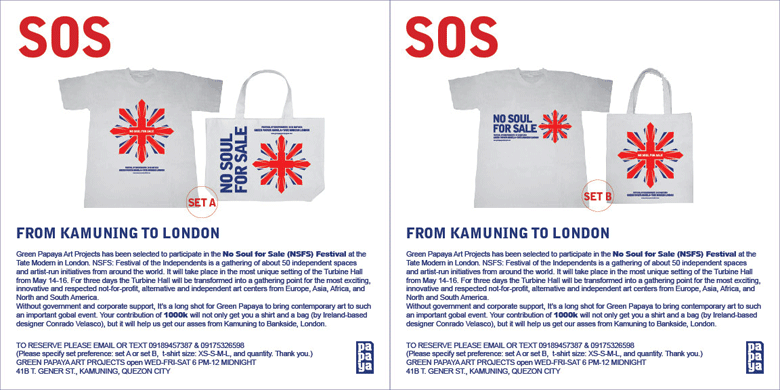
Green Papaya Art Projects, the artist-run initiative/artspace of Norberto “Peewee” Roldan located at T.Gener Street near Kamuning, has been selected to participate in the No Soul for Sale (NSFS) Festival at the Tate Modern in London. NSFS: Festival of the Independents is a gathering of about 50 independent spaces and artist-run initiatives from around the world. Without government and corporate funding, it’s a long shot for Green Papaya to bring contemporary art to such an important global event. Your contribution of P1000 will not only get you a shirt and a bag (by Ireland-based artist Conrad Velasco) but it will help the good people of Papaya from Kamuning, Quezon City to Bankside, London where the festival will be held.
To reserve, please text 09189457387 and 09175326598.
Tuesday, March 30, 2010
ARTIST IN RESIDENCE ] Patty Eustaquio and her dear, sweet, not-so-filthy new space
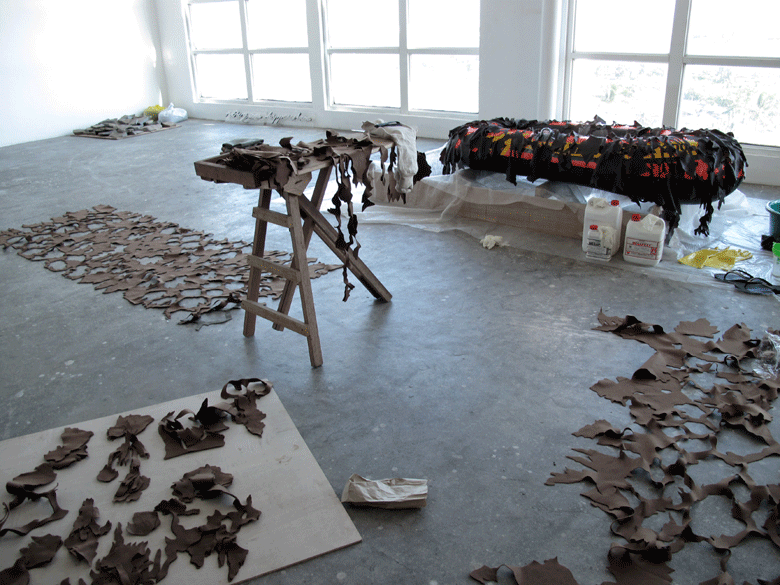
The first time I saw an exhibition of works by Patty Eustaquio, it felt like I suddenly was allowed entry into an empty auditorium and, while there was no orchestra or some sort of piped-in music, an aria was definitely being sung somewhere--you almost expect a soprano to enter from the backroom. It mattered little that the venue, the sLab space of the Silverlens galleries, used to be an auditorium and piano school, and that the title of the exhibition was Death to the Major, Viva Minor.
It was a rare occasion of fabulosity in the usually same-same mood of art openings. There was something so grand about the atmosphere that evening, the space full of beautiful things. Open hearts of animals in canvases the shape of fowls in graceful flight. A white violin sliced to reveal what seems to me a heart. A crochet lace piano cover--dyed the color of tea to make it seem old, soaked in epoxy so that it stands as if draped into an invisible piano. Everything evocative of the things one associates with Patty: a penchant for old things, a languorous femininity, a beautiful kind of sadness. 
Her new show, also at sLab, which I haven't seen, seems a continuation of the motif that began with that show from 2009. In this one, however, the music is specific. She has chosen Elvis Costello's "Dear Sweet Filthy World" (also the title of the show) to become sort of a musical score for her new works: oil paintings, cardboard sculptures, and boats cut from felt and, much like her much-loved 'piano,' cast in epoxy resin.
We asked Patty about her new works, her new studio (photographs of which she very kindly snapped for Swank) and the lyrical quality of her pieces.
Describe your new space, the size of it, the look---from when you found it to how it looks now.
I love my new space because I've never had so much space to work in. It's a high-ceilinged open type space. It was a storage room when I found it, so it required a lot of work: a lot of cleaning, plumbing. I built rooms just so I have some privacy, but the entire flat is my work space.
How much time do you spend in your workspace?
I hardly ever leave the studio.
The show in Silverlens were all created in this new space? Would you say the space in a way have touches of influences on the works?
Yes, I made everything in the new space. I don't think I would have managed to make such big pieces if I didn't have the new space. But I did already have all the works in mind, which is why I was in such a rush to move in.
What drew you to Costello's "Dear Sweet Filthy World," a suicide note with music?
I love Elvis Costello--three out of four solo exhibits were titled after his songs. But I particularly cling to "Juliet Letters" because I love the irreverence of the content, the mix of violins with this sound that still sounds new to me, even if I've heard it a million times. "Dear Sweet Filthy World" is just so melodramatic that it's funny. Not laugh-out-loud funny, but the kind where you shake your head and say I can't believe someone can sing and play this mockery so beautifully like Elvis.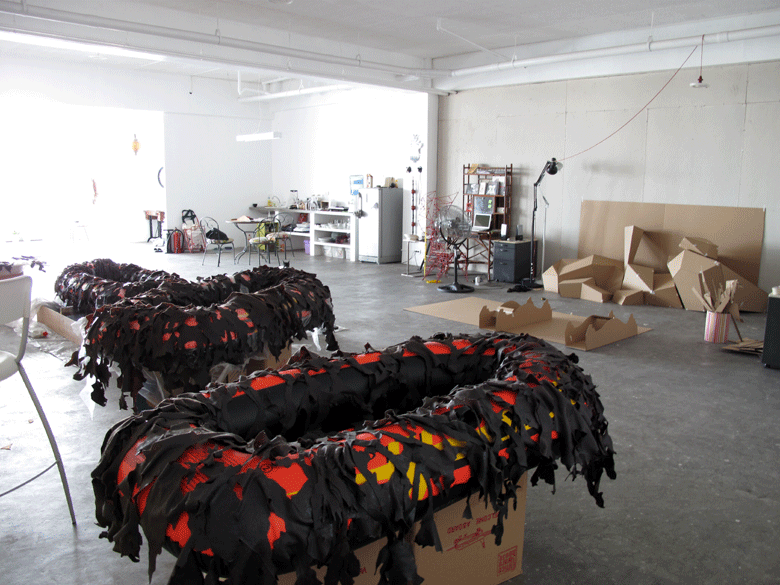
The first time I went inside sLab and you had a show, there was something not just plain musical, but operatic about the entire space and the pieces (and not only because there was a crocheted piano)---do you like working with music? Is it an essential part of how you work?
I do listen to music while I work, and usually when I'm feeling particularly dim about my work, I go about searching for new music to listen to. I'm drawn to music with beautiful lyrics--- probably because I spend nearly all my time alone so it's almost conversation. But also because I find that new music challenges me to put things together in a way I haven't tried. I do like songs that have an operatic feel, Costello is a lot like that. Antony and the Johnsons is an artist I listened to 24/7 a couple of years ago until I tired myself out. I think I like music that feels big and old, but is also so contemporary in its sensibility so that you feel like there's an amplification of what's going on, albeit a non-mainstream event.
Since we're talking about your new space, what's your favorite area/element in it?
I have tall windows lining an entire side of the cube, so I get lots of light all day. I have a view of parts of the gritty city, but there are hills beyond, Laguna de Bay and Makiling in view especially on a clear day. It's quite something to wake up to. It gives you perspective of where you are and what you have.
How do you begin a day?
Two espresso shots, toast and fruit. I'm a creature of habit. If something ruins my routine, I find it hard to work the rest of the day.
Dear Sweet Filthy World is on exhibit from March 17 to April 17, 2010. It runs simultaneously with POSTLOCAL: Painting with Bruihn, Nona Garcia, Anna Varona, curated by Isa Lorenzo; A Country
Road. A Tree. by Jet Pascua.
On April 17, Saturday from 3-5pm Eustaquio elaborates on Dear Sweet Filthy World, where the construction of memory is built alongside her narrative "to convey the irony of our feeling towards reality, the realities in life, the world."
Thursday, March 4, 2010
MODERN LOVE ] Tomorrow night, Paulino Que is bringing out the jewels from his palace
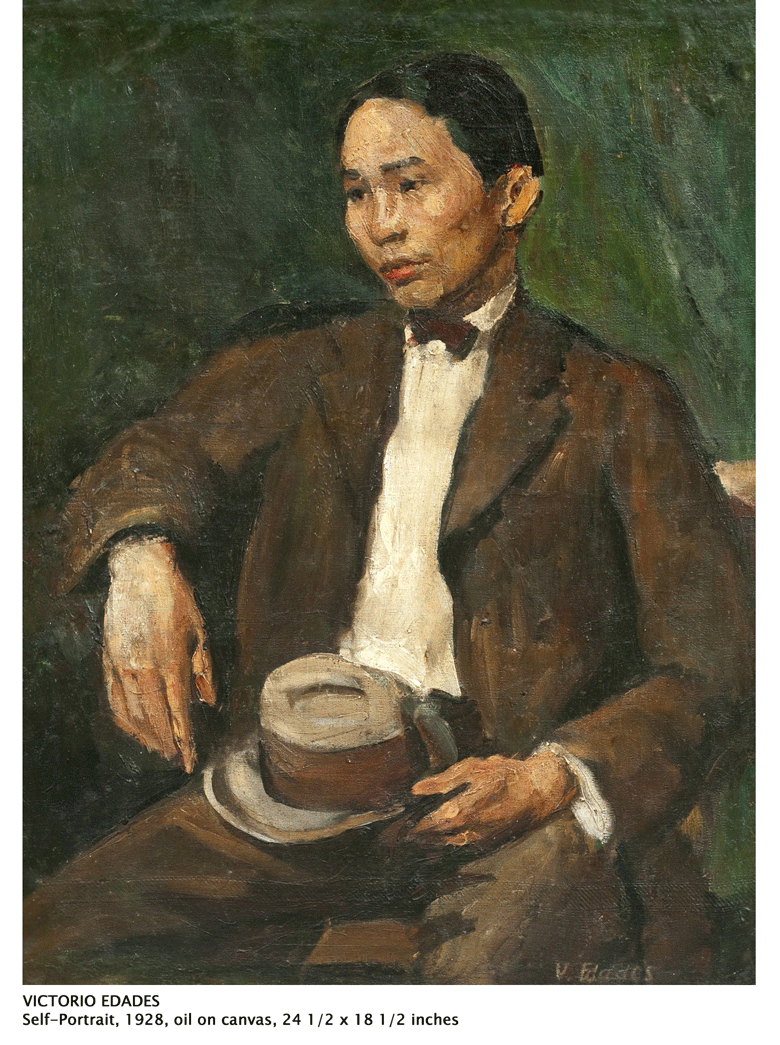 Image courtesy of Finale Art File.
Image courtesy of Finale Art File.
Finale Art File is proud to showcase “Meaning To Be Modern”, a selection of Philippine paintings from 1907 to 1959. The exhibition presents a vital part of art patron Paulino Que’s vast collection of Philippine art and antiquities. It focuses on the early periods of Philippine modern art, spanning the initial phases of the movement with Victorio Edades, his precursors Juan Arellano and Diosdado Lorenzo, and peers Galo Ocampo and Carlos Francisco, as well as the developments thereafter: the Thirteen Moderns, incipient and late neorealism, and abstraction on the cusp of the Sixties. 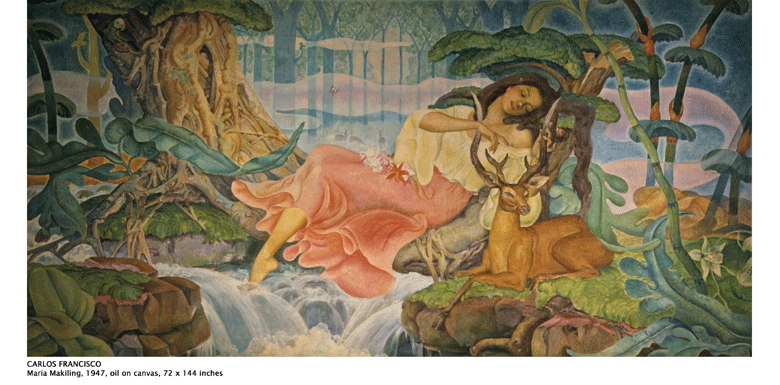 Image courtesy of Finale Art File.
Image courtesy of Finale Art File.
This collection is exceptional and exemplary, surveying the watersheds of Philippine modern art, from the early part of the 20th century to the Sixties. The Fifties may be considered the high point of the process of modernity in Philippine art, preceded by years of debates with the Amorsolo conservative school of romantic realism, experimentation with a range of styles from the school of Paris, and the formation of a distinct visual idiom of modern art that was cosmopolitan and uniquely Filipino.  Image courtesy of Finale Art File.
Image courtesy of Finale Art File.
Aside from the art works, this collection also brings to light the significance of the Paulino Que collection, which is one of the most indispensable in private auspices and could rival the combined treasures of public institutions of modern art collection such as the National Museum, the Cultural Center of the Philippines, the Ateneo Art Gallery, and the Vargas Museum. Featuring 36 artists and 80 works, it promises to be an event in itself, a rare occasion in which a private collection becomes public discourse as students, scholars, and supporters of Philippine art gain access to it and hopefully engage it with the same discernment that went into its shaping.
The exhibition will run from March 6 to 31, 2010 at Finale Art File, Warehouse 17, La Fuerza Compound, (enter Gate 1), 2241 Pasong Tamo, Makati City. Student tours are welcome. Should you request a guided tour, call 8132310 or email finale@pldtdsl.net. Admission is free. Finale Art File is open Monday to Saturday, 10am to 7pm.
Wednesday, March 3, 2010
FRESH PAPAYA ] A favorite space undergoes a little retweaking
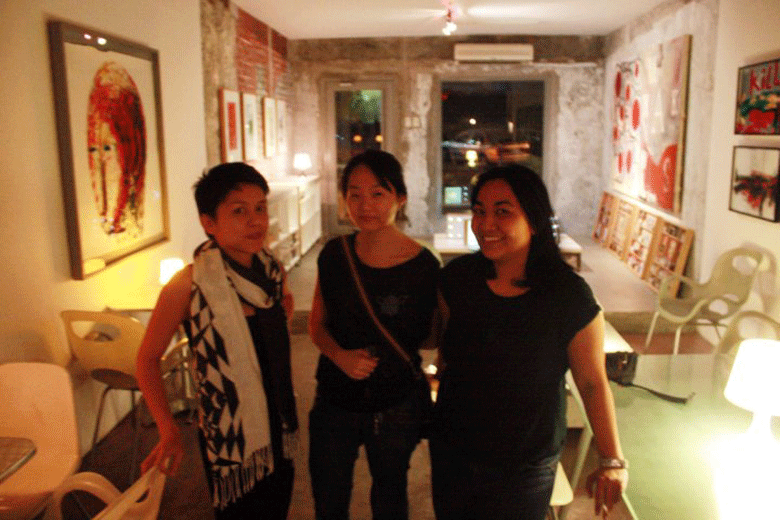 Post-reopening guests, artists Patricia Eustaquio, MM Yu and Nona Garcia.
Post-reopening guests, artists Patricia Eustaquio, MM Yu and Nona Garcia.
Of the local galleries, Green Papaya holds a distinguished spot. It can be outrageously intellectual one moment, say, in exploring the interrelationship between performance and dialogue (“The snobbish tone of a roundtable discussion belies the possibility of taking something much seriously than how it already appears to be because surely there is nothing as tedious than witnessing steadfast attempts of repeating patterns to the point of their own exhaustion.” Whew, ka-exhaust.) Or when talking about the annual Serial Killers group show (“Serial Killers is a response to parallel notions of seriality, non-seriality, or counter-seriality.”). Still, from that high up, nowhere in the art scene is the atmosphere most grounded than at the rough-around-the-edges halls of this space near the corner of T. Gener Street and Kamuning Road in Quezon City.
Here, far from the polished, finished walls of the spaces everywhere else, despite the occasional presence of collectors and other demigods, the artist surveys the new works of their colleagues, then parties about unencumbered, owning the space like home. Maybe it’s the artists who run it. Maybe it’s the San Miguel. The thing is, no matter the culprit, Green Papaya is—to use a not-very-cool description—fun. And now that the space is on its third incarnation—as a full-fledged bar but with art on the side—the interiors remain possessed of its original resolve: to carry the best and, ugh, wasak in contemporary art, and to give the community an all-embracing second space to come home to.JG 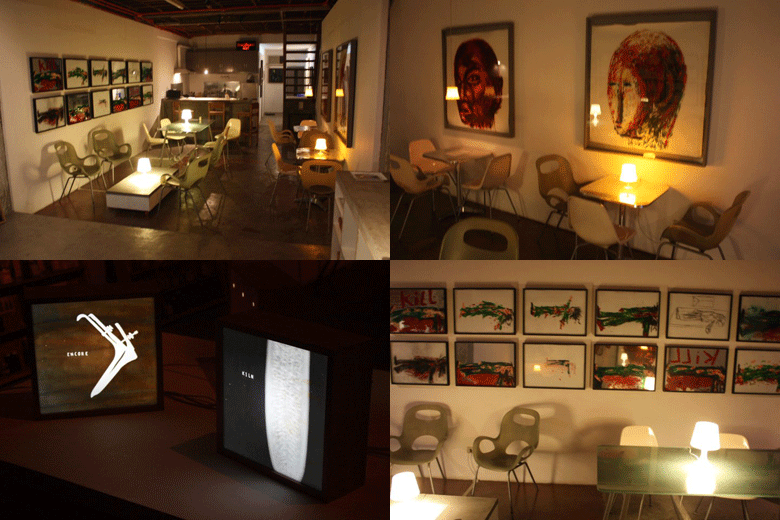 The ground floor space is the bar and art shop (selling small, old works by the likes of Maria Taniguchi and Nona Garcia), the second floor has been turned into a studio and living space for artist and gallery owner Norberto "Peewee" Roldan. Clockwise from top left: the bar had been moved further to the front and serves, the last time we were there, red wine, vodka, Johnnie Walker and beer, of course; works by New York-based artist Gaston Damag unearthed from the Papaya archives; more works by Damag who recently had a show of installations at sLab; and lightboxes by Nona Garcia.
The ground floor space is the bar and art shop (selling small, old works by the likes of Maria Taniguchi and Nona Garcia), the second floor has been turned into a studio and living space for artist and gallery owner Norberto "Peewee" Roldan. Clockwise from top left: the bar had been moved further to the front and serves, the last time we were there, red wine, vodka, Johnnie Walker and beer, of course; works by New York-based artist Gaston Damag unearthed from the Papaya archives; more works by Damag who recently had a show of installations at sLab; and lightboxes by Nona Garcia.
Green Papaya Art Projects is located near the corner of T.Gener Street and Kamuning in Quezon City. It's open from 4pm onwards Wednesdays, Fridays and Saturdays.
Photographs by Rico Quimbo.
Tuesday, March 2, 2010
ARTIST STATEMENT ] Argie Bandoy will give you a topic. 14 topics. Discuss.
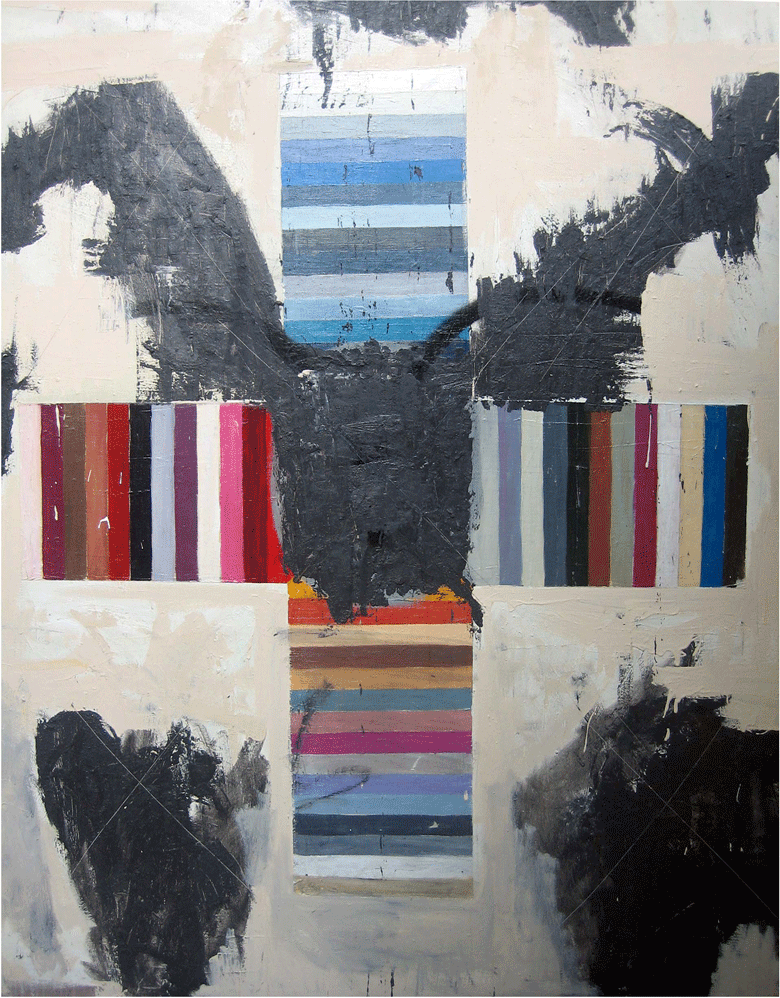 Argie Bandoy, 2010. Image courtesy of Nova Gallery.
Argie Bandoy, 2010. Image courtesy of Nova Gallery.
2. Painting is Brash and brute and dirty.
3. A Bad painting is a good painting.
4. Painting by manhandling the paint.
5. A good painting only exists in the imagination.
6. Painting always asks for more.
7. Painting is superficial.
8. Painting demands the painter’s flesh and blood.
9. A painter is a delusional being.
10. A Painting always contradicts the painter.
11. Aiming for Beauty produces unpleasant results.
12. Repulsive is better than playing nice.
13. Bad humor is always the best.
14. Painting is a cerebral activity.
Artist Argie Bandoy will show his new collection of works entitled “A discourse on bad taste and guilty pleasures” this Friday, March 5 (will run up to the 25th) at the Nova Gallery, La Fuerza Compound, 2241 Don Chino Roces Ave., Makati City. For more information call 392-7797 or send an electronic mail to gallerynova@gmail.com.
And since we're on the discussion of discussions, what do you think of this?
Sunday, February 28, 2010
ARTIST IN RESIDENCE ] Robert Alejandro opens his personal space to Swank
my favorites is the giant 26" clock. I'm not sure why I collect clocks
but I do know I like being on time."
Robert Alejandro has designed numerous award-winning books, magazines, retail shops, theme parks, and graphics for public spaces. As part of the family behind the enduring gift shop Papemelroti (he puts the “ro” in Papemelroti), he has also designed products, memo pads, calendars. But, when it comes to his personal space, it seems the artist has taken to a more organic way of designing, nay, evolving a look for it—filling the room with his favorite things and allowing the mixture of collectibles and personal mess create a unique, endearing world. "Yes, I know my room is a mess," he tells us. "I've meant to clean it for years!" We like it just fine.
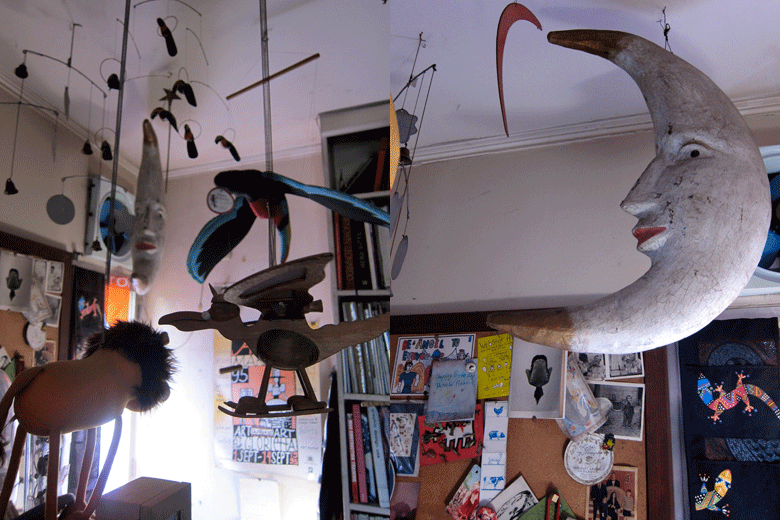
and everything in between. It's easy to know when there's an
earthquake." RIGHT "My favorite papier maché piece is my 'moon--he is two-feet high and has a GREAT smug expression!"
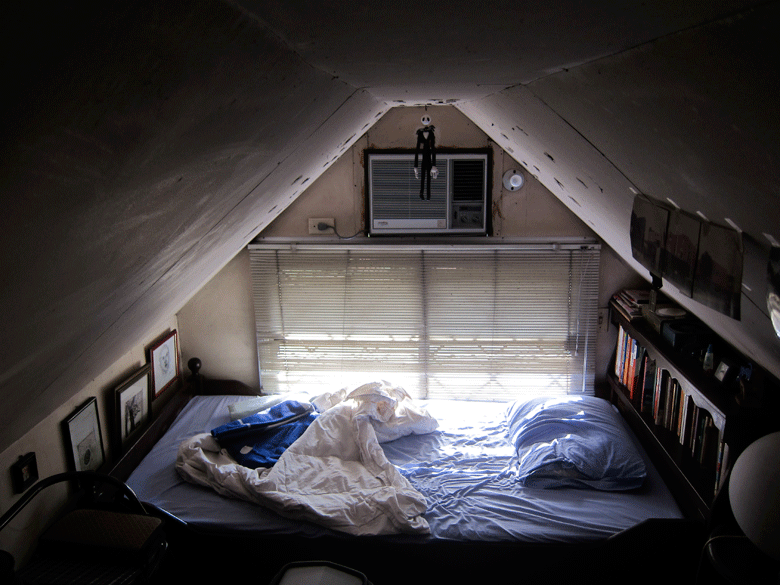
hit my head on the ceiling quite often. Keeping me company above my
bed is Jack Skellington (doll) given to me by my friend Karen (We
both love Tim Burton)."
Robert Alejandro is also an avid traveler. Two years ago he went around nine countries in Southeast Asia and parts of China in 10 days with a P50,000 budget. He writes about it and, more importantly, sketches the places and vignettes he encountered in The Sketching Backpacker, available in Papemelroti outlets for P390.
Saturday, February 27, 2010
IT TAKES AN ISLAND ] Tammy David trains the camera on herself
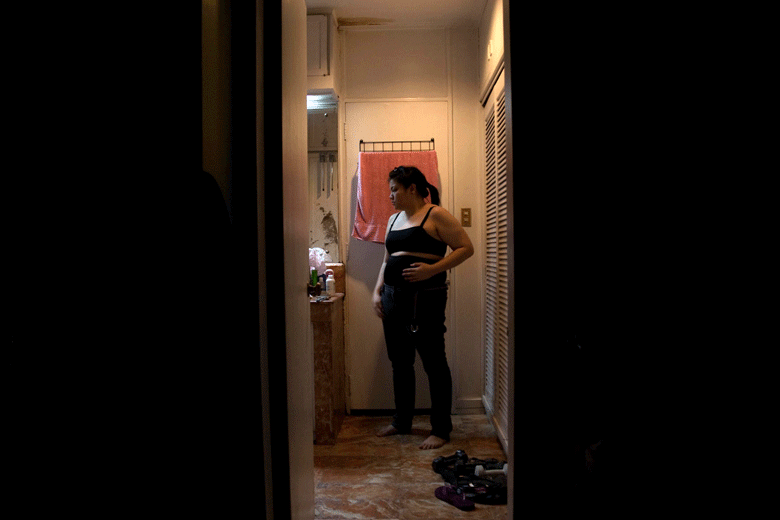
Tammy David is a 27-year old photographer. Her series of self-portraits called It Takes An Island is currently on display at the Silverlens Gallery in Pasong Tamo Extension along with two other shows, also documentary works, by Jake Versoza and Veejay Villafranca. TheSwankStyle interviewed Tammy David recently, albeit only via Facebook, on the occassion of this, her fourth group show, and her first for Silverlens.
You photographed yourself. Why?
I joined a portraiture workshop last September under German photographer Espen Eichhöfer. My original class project was to produce serial portraits of people experiencing quarter life crisis. That didn't work out so I had to resort to my back up which was self-portraits. I had to do it cause I didn't want to fail. Surprisingly, this is the project which got the most positive feedback. Personally, it turned out to be a terrific learning experience since, as what a young American photographer said, 'How can he take intimate photographs of other people when he can't do the same to himself?' I can now understand my subjects more.
This is like telling the world you have a weight issue, which isn't something a lot of people would do.
I have always been vocal about my weight issues from writing about it in the paper to tweeting about my 6-course merienda. In the past I have been invited to model in magazines as a person of size but refused because I know the impact is different when it's visual. So when the time came to do my self-portraits, I had to remind myself I had to produce a damn good job. My goal was to please myself as a photographer and not attract a potential husband or a talent scout. Self-portraits are supposed to reveal things about the subject and with me, it includes late night eating in a parking lot and wearing spanx. I was consoled by the fact I only have to show it to the instructor and eight other students. I just didn't expect Silverlens to give me the opportunity to make it into a show six months later. Even during the opening reception I got myself a bit drunk since it still felt uncomfortable seeing people look at photos of me in my bathrobe. But it felt good seeing people laugh at my photographs instead of feeling sorry for me or worse, look away.
What camera did you use for the works in the show?
I used a Canon EOS 30D with a Sigma 17-70 lens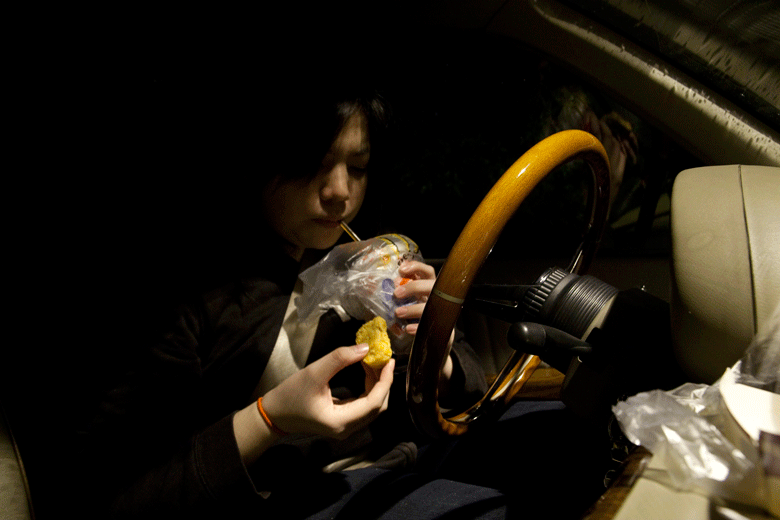
Can you describe to me the physical work involved in setting up these photographs? Were they shot at home, etc, was there anyone else in the room?
They were shot at home, office, my gym's locker room and inside the car. All photographs were taken with the self-timer function. There came a point I got used to taking pictures that I would even leave my gear in my car trunk just in case. One of the best compliments I got was from my cousin who refused to believe I took the photographs when in reality, I was alone the whole time. It means I am a pretty good actress or despite the set up, it feels authentic.
What drew you to photography?
My dad is a hobbyist and would pass on his old cameras to me. When I was 16, I was writing for the youth section of a national broadsheet then and I got paid more with photos compared to text. For a teenager, extra cash was always good. Around the same time I was exploring journalism, I was moved by the works of photojournalists Romeo Gacad, James Nachtwey, Dan Eldon and the Magnum photographers. I realized I was able to express more through photographs and used photography as an introspective tool so I stopped writing and focused more on photography.
Who are your influences?
When people look at my work, they feel I am heavily influenced by Western photographers which I can't really deny. It's the Western photographers who flooded National Geographic, Time, World Press Photo awards, Phaidon books plus had a strong presence in the Internet. I have a couple of influences who I am blessed to consider as mentors as well. Renowned Filipino photojournalist Romeo Gacad of Agence France Presse (AFP) is one. I was only seven when I came across the book 'Bayan Ko' and it made me want to be on the frontline of history as well. Another is Jose Enrique Soriano who in my opinion is one of the best documentary photographers ever. The depth of his work on mental patients affected and inspired me to do more stories instead of the single image. Lastly another big influence in my life as a photographer is Peter Bialobrzeski. Taking his workshop in January 2008 at Silverlens taught me professionalism and to be more open to other work. I'm self-studying now on German Photography and I'm excited to get a copy of Dusseldorf School.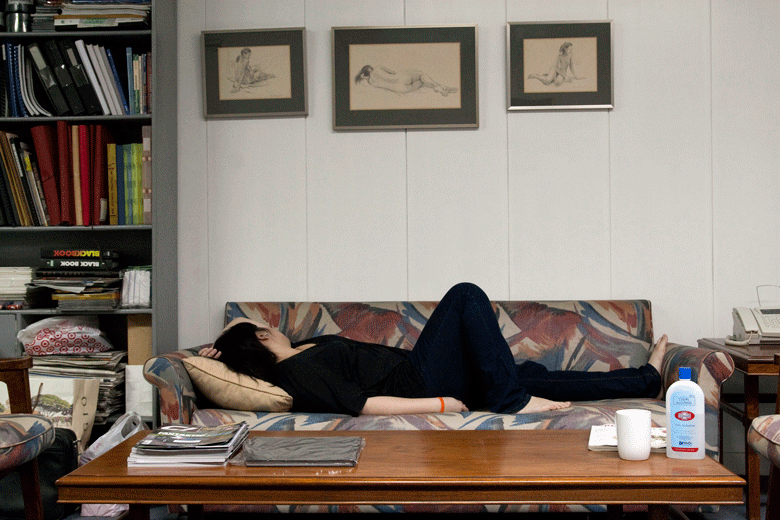
Are there particular subjects that are most attractive to you?
I like to do documentaries that are offbeat which is not a lot of blood or poverty. I credit my curiosity to two of my personal projects namely Beauty Queen Boot Camp and Fat Acceptance in America. Most of my work is about women because I obviously have an advantage in terms of access and a lot of people want to know more about women! I also like stories that are very positive that will leave the audience with a smile instead of a heavy feeling in their chest.
Tammy, Jake and Veejay give a free talk today at 3pm at Silverlens on documentary photography.
Friday, February 26, 2010
THE WEEKEND IDEA ] If you're not watching The Backstreet Boys
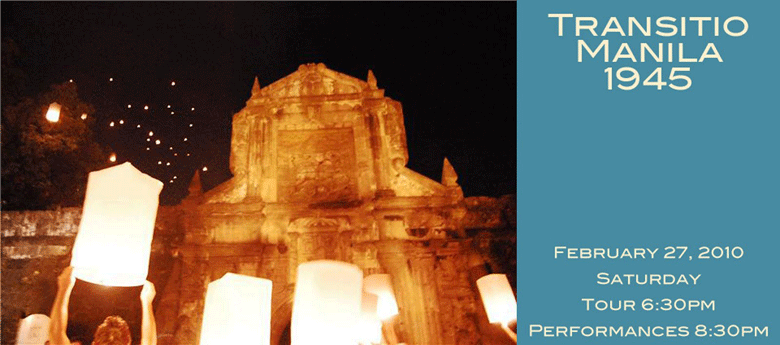 The invite to Manila Transitio 1945 via celdrantours.blogspot.com.
The invite to Manila Transitio 1945 via celdrantours.blogspot.com.
In February of 1945, the City of Manila was completely destroyed in a battle between the United States Armed Forces and the Japanese Imperial Army. An estimated 120,000 people were lost and our beloved City of Manila was never the same again.
Tomorrow February 27th, To mark the 56th Anniversary of the Battle of Manila,Intramuros Administration and Carlos Celdran, will present the 2nd TRANSITIO MANILA 1945. This art event hopes to become an annual commemoration/memorial where we as Manilenos may reflect upon the passing of this event in our history. The evening will start with a sunset fundraiser tour of Intramuros at 6:30. Art installations and performances will follow at the Fort Santiago at 8:30pm. The evening will be highlighted by the release of spirit balloons by the gates of Fort Santiago. A reasonably priced buffet and refreshment will be available. Picnic baskets are allowed.
EVENINGS ACTIVITIES AND COSTS:
TOUR
6:30PM
I will be holding a SPECIAL sunset tour of Intramuros. It will be a bigger show than the usual. The tour will be followed by a special party at Fort Santiago. Ticket holders to the tour will enter the party/picnic for free and recieve a free glass of wine. Tour starts at 6:30PM - Please arrive earlier than that. Tour ends at 8:30PM
Php1,000.00.
Assembly point is Plaza Roma in front of Manila Cathedral.
Proceeds will go towards the procurement of scooter bikes for the Intramuros Kabayan Security Force (An NGO).
MANILA TRANSITIO 1945 ART EVENT
8:30PM
Gates open by 7:30PM
The evening proper will start with readings about the Liberation of Manila curated by Mabi David and a performance by Donna Miranda, it will be followed by music by Junjie Lerma, Caliph8, and P.G. in the gardens fronting the moat. Flamenco music by Yerbaguena will follow. There will be an exhibition of art installations by Denis Lagdameo, Dranreb Belleza, Reg Yuson, Tad Ermitano & Team Manila. Current artists in residence at the Living Room Vince Galvez and Alex Felipe of Kapisanan Toronto will also present a video work specially made for the evening. The evening will be capped by the release of spirit balloons at the gates of Fort Santiago (video above).
Feel free to pack your own picnic basket and set up a blanket in the grass to watch the performances. A reasonably priced buffet (Php450.00) by Ilustrado Restaurant will be available for those who do not bring their own food. Vuqo Vodka will be available and a wine bar by PREMIER WINES & SPIRITS. www.sexandsensibilities.com and Frenzy Condoms also supports the event.
Entrance to this event only is Php250.00 with a free drink.
Text 920 9092021 to make reservations (Lesley)
or email celdrantours@hotmail.com
Please indicate on text whether you are reserving
for TOUR alone or TOUR/PARTY or PARTY only.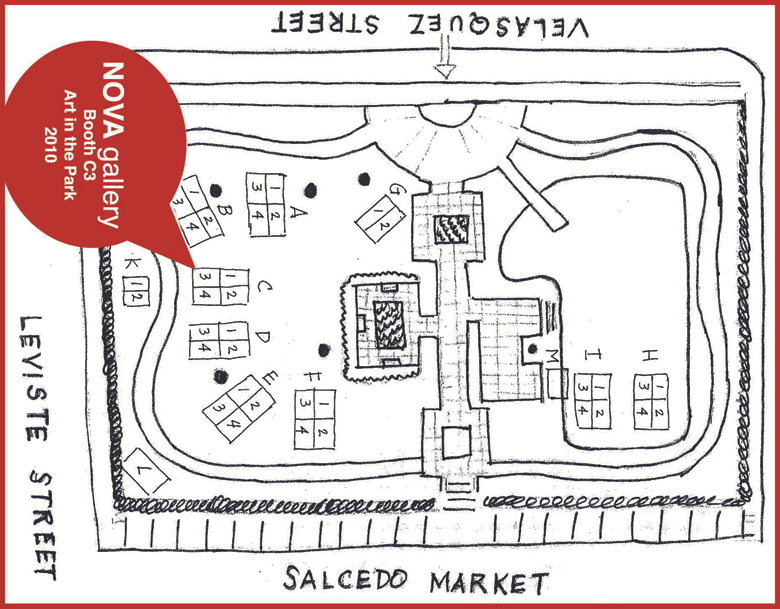 Stall map of Art in the Park in Salcedo Village.
Stall map of Art in the Park in Salcedo Village.
Or take a stroll at Art in the Park this Saturday 27 February 2010 at the Jaime Velasquez Park at Salcedo Village, Makati City from 2PM - 10PM.
NOVA Gallery shall be participating this year taking with works by Norma Belleza, Jayson Oliveria, Trek Valdizno, William Gaudinez, Nunelucio Alvarado, Raul Agner, Ofelia Gelvezon-Tequi and a lot more.
Thursday, February 25, 2010
MISSING A PAIR OF SOCKS ] Is that, like, crazy?
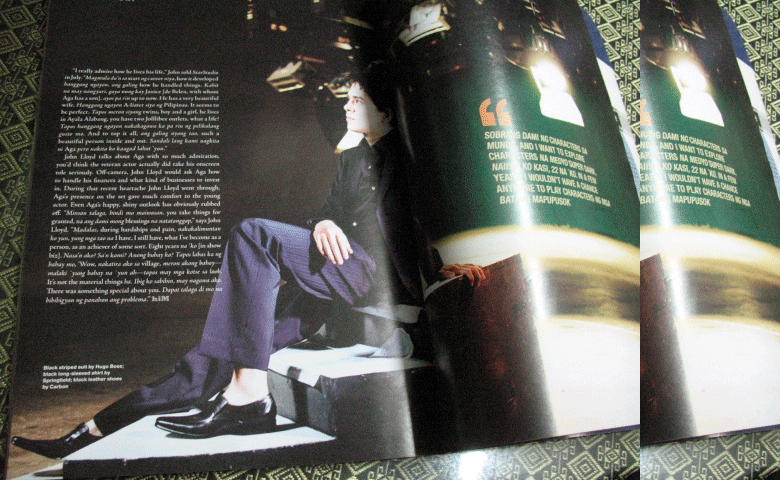
Is this where it all began? JLC was photographed--sans socks--by Steve Tirona for a 2007 cover story in Metro hiM.
John Lloyd Cruz would inevitably find himself in this blog, but for now just about the pressing issue of his exposed ankles. The guy, certainly one of the few stylish chaps in the entertainment business, has been going around town for awhile sockless, whether for a formal occasion or in a less dressy one. At the last Star Magic ball, at the Swatch event that launched him as the watch brand's endorser (see photo below by Cecile Zamora). He came to the YES! 10th anniversary party (dress code: smart casual) and his movie premiere in a grey suit with abbreviated pants and patent slip-ons. And yes, sockless.  Personally, I find it cute and refreshing, as most of his decisions tend to be (I’m a JLC fan, if I have not made it clear to you yet.). Personally, too, I have yet to be adept at wearing socks. Mostly I don’t. I usually just wear a pair to the gym or when running. Everywhere else, nothing comes between me and my choice of footwear. Except when I am quite aware that the shoes will be a bit of a discomfort given a few hours of wearing them—in this case, I have several pieces the eminent stylist Michael Salientes calls ‘socklets,’ which I have come to define as cutting the sock in two and wearing only the part that the shoe itself covers.
Personally, I find it cute and refreshing, as most of his decisions tend to be (I’m a JLC fan, if I have not made it clear to you yet.). Personally, too, I have yet to be adept at wearing socks. Mostly I don’t. I usually just wear a pair to the gym or when running. Everywhere else, nothing comes between me and my choice of footwear. Except when I am quite aware that the shoes will be a bit of a discomfort given a few hours of wearing them—in this case, I have several pieces the eminent stylist Michael Salientes calls ‘socklets,’ which I have come to define as cutting the sock in two and wearing only the part that the shoe itself covers.
Maybe I just have to get accustomed to how socks look on me. Or maybe I just need to buy some. Two of my friends, however, have formed, shall we say, more evolved opinions on this matter of traipsing about sockless.
J. Lee Cu-unjieng, the other JLC in this story, and certainly one of the most stylish guys in town, says, “First, I think it depends on the shoe. Driving shoes, boat shoes, espadrilles and of course, any kind of slide or sandal, should be worn without socks. Penny loafers also may be worn sockless.
“And then it depends on the look. If you've embraced the ankle- grazing pant leg look (or shorter, like Thom Browne’s), that automatically signals going without socks, no matter the shoe. And any sort of walking short should be worn without socks. And I find it acceptable to be sockless in your khakis, too.”
Carlo Tadiar, another stylish bloke, has a more exacting, if more perplexing, take.
“In my view it is rarely acceptable for a man to wear leather shoes without socks unless he is a fashion model appearing in a fashion editorial,” says Carlo, editor of the dearly departed Metro hiM. “Nothing could be more embarrassing (and I suppose I exaggerate for emphasis) than being handsome, tall and thin and taking off your sockless shoes to reveal a woman's nylon socks on your feet. This happens more frequently than you might imagine in shoe stores in New York, and I would think in other fashion capitals. We all know that men's shoes are uncomfortable without socks, and the only way to achieve the fashion is by cheating. Nothing could be more un-stylish than straining for effect. If you were something out of Carlos Bulosan, in an ill-fitting suit and fedora and brogues without socks, that might be chic. If you're from Greenhills with a Gucci tote and John Bartlett oxfords without socks, that is not.”
Maybe going for no-socks, as the two JLCs would have it, is easier. Now about those orange shoes, that’s another story.
Monday, February 22, 2010
GANGLAND ] Veejay Villafranca shoots the gangs of Baseco
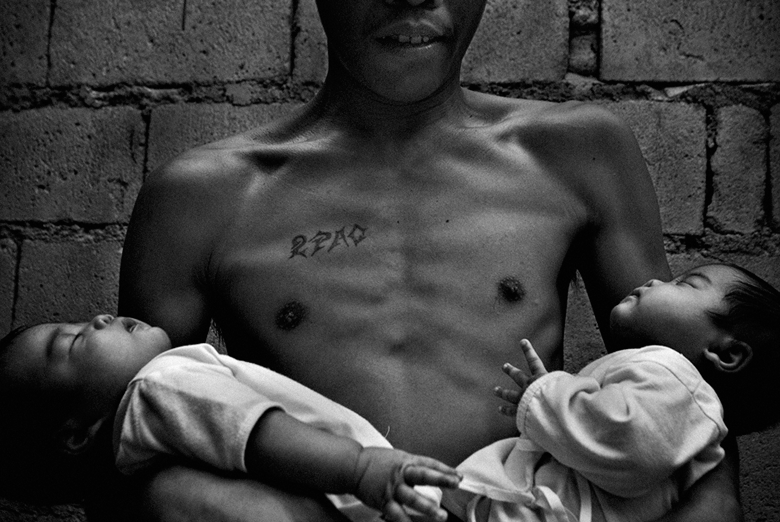
In 2007, photographer Veejay Villafranca began toiling on Marked: The Gangs of Baseco as part of his final portfolio in his photojournalism class at the Asian Center for Journalism of the Ateneo. It took him two years before he could finally wrap up work. “During the first year and a half of the project, I would be there almost every day,” he says. “It also came to a point where I was already looking for a small space in the compound. Then the succeeding year I would make it a point to visit at least twice a month.”
Baseco is, of course, not the swankiest of places to live in. Situated in Port Area, Manila, it is made up of 52 hectares of reclaimed land and there are more than 47,000 families living in shanties standing on stilts rooted on swampy grounds. Occasionally, the polluted waters of Manila Bay would even find its way to these ramshackle homes. “It was purportedly built as a world class resort by former First Lady Imelda Marcos,” says Veejay, “but turned out to be the town where dreams of greener pastures have perished.” Baseco actually stands for Bataan Shipping and Engineering Company.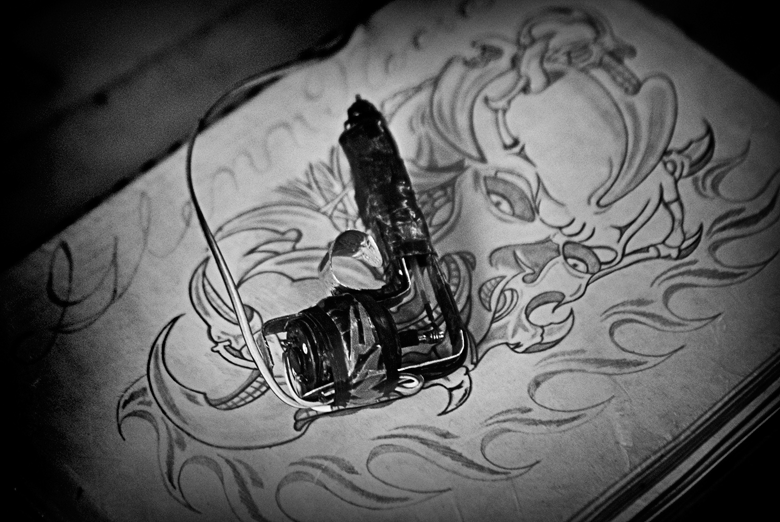
While the entire former shipyard was certainly overwhelmingly throbbing with various unsettling subjects, the young lensman zeroed in on the gangs, particularly the Chinese Mafia Crew.
“You know one person recently made a comment about my photos,” Veejay tells Swank. “She said she works daw as a nurse in the compound and she was asking, inspite of my 'brave' efforts to document the gangs, why not tell the story of everything 'good' that was happening and that has happened in the area. I said, ‘You see when I met these people, they were hostile. They didn’t want to talk and they were very apprehensive to be photographed. When the time came that they opened up na and accepted my intrusion, I was greatly humbled and thankful. As I continuously documented their lives, I grew as well. From the dangerous nature, tattoos and drugs, I saw that they are young hopefuls longing to get out of the vicious cycle. I have learned that one by one they have been disappearing from the slums because most of them are already working. This was the same reason I documented this story. Another story of poverty and struggle, but a new story of hope and change.”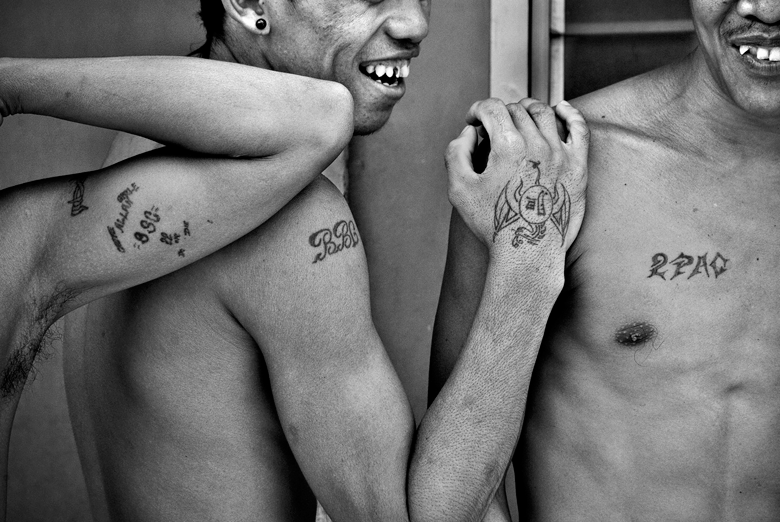
Just recently, Veejay found himself back in Baseco, although for an assignment not related to the gangs. “I dropped by in one of the gang members’ houses. The mother was there, but the guy wasn’t. She said he was working and would only go home during weekends. That made me smile.”JG
In 2008, Marked: The Gangs of Baseco won for Veejay the Ian Parry Grant. Ian Parry was a young photographer who died in a plane crash in Romania. As a tribute, his friends and editors set up this award in London for young emerging photographers every year. Marked is part of the ongoing three-man photography show (with Jake Versoza and Tammy David) called STRIP 2010 at the Silverlens Gallery in Pasong Tamo Extension.
Images courtesy of Silverlens. For more of Marked and Veejay's works, click here.
Sunday, February 21, 2010
COMMUNAL IDENTITY ] Jake Versoza photographs the not-so-everyday
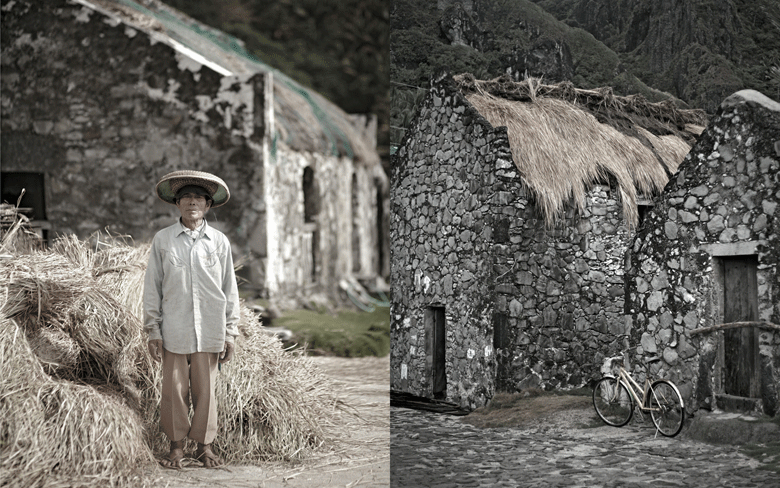 Ivatan by Jake Versoza.
Ivatan by Jake Versoza.
"Communal Identity" documents the different faces of the indigenous peoples of Southeast Asia--faces the world seldom gets to see, much less get to know about. Bearing witness to the living cultures of the region, Jake Verzosa’s work records the details of the people’s everyday lives, from their clothes and chores, to their homes and landscapes. His ethnographic theme is strong, but is not limited to documenting the ‘other’. Also looking inward, Verzosa’s documentary makes it clear that the differences between people are circumstantial, and therefore not prime in understanding human nature. Everyday life is the same everywhere. There is routine; there is a need to make a living; and there is a want for expression. Igorot by Jake Versoza.
Igorot by Jake Versoza.
Communal Identity, which Versoza has exhibited last year in Paris, is one of three collections of works included in STRIP, a new annual photography show by Silverlens Gallery. STRIP features three young photographers who are all about documenting the here and the now. In a time when photojournalism has been replaced by video and live coverage of world events and everyday news, Tammy David, Verzosa and Veejay Villafranca (David's and Villafranca's works will appear in the following posts) hold on to the power a photograph has in telling a story. Their stories are still about bridging the gap between subject and audience, but this time with more emotion and revelation. Hmong by Jake Versoza.
Hmong by Jake Versoza.
STRIP 2010 will be shown alongside Malikmata by Mark Orozco Justiniani at SLab and Saucerful of Secrets by Mariano Ching with Haraya Ching at 20SQUARE, SLab. STRIP 2010 Artists, Tammy David, Jake Verzosa and Veejay Villafranca will have their Artist Talk on February 27, 2010, Saturday, 3-5 pm.
Images courtesy of Silverlens.
Friday, February 19, 2010
WHERE WILD THINGS ARE ] Mark Justiniani explores unfamiliar territory
 Justiniani's studies for Malikmata.
Justiniani's studies for Malikmata.
Celebrated painter, Mark Orozco Justiniani, veers his latest work away from the medium he has long been associated with and instead takes it to the world of sculpture where corners and frames cannot bind. This world, entitled Malikmata, is one where night and day converge, and folklore and reality abandon their distinction.
Justiniani’s keen interest in Filipino society and tradition takes the sculptural route to present Filipino folklore in a form that is multi-dimensional, concrete and tangible. Not only do the eyes find the splendor of the earth as the sun sets and shadows creep in; this in-between too awakens the other four senses, and at the same time stirs the imagination. Meant to heighten every sensation, Malikmata, Justiniani explains, involves a lot of ‘ “looking through” with peepholes and lenses with several angles and different vantage points’. With viewers’ participation, the world Justiniani creates is sculptural commentary infused with physical interaction.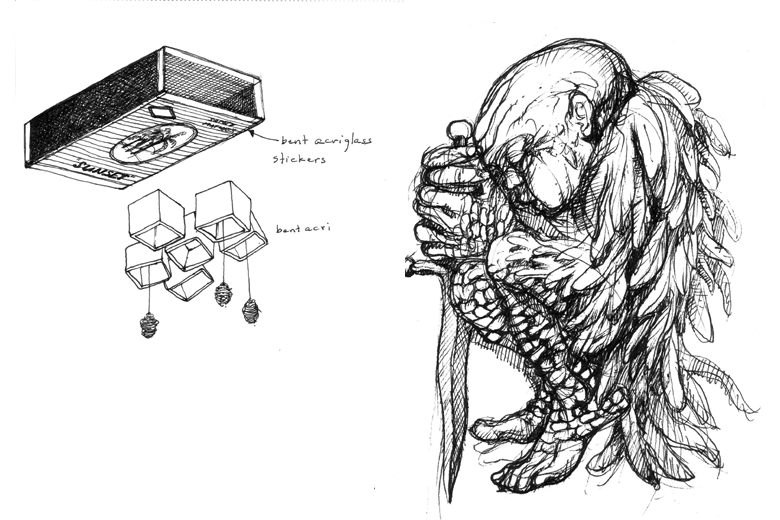 Two more studies for Malikmata.
Two more studies for Malikmata.
Malikmata opens tonight, February 19, with two other exhibitions at Silverlens.
Saturday, February 13, 2010
ERAP BEFORE ERAP ] My favorite scene from Quijano de Manila's Reportage on Crime
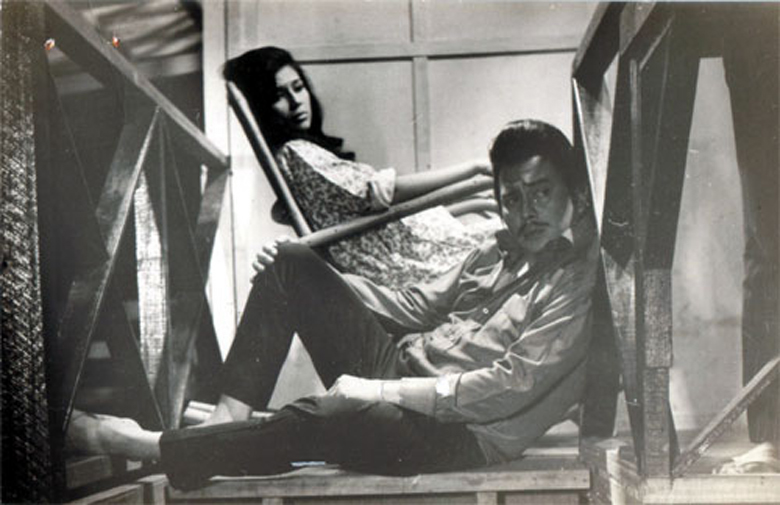 With Boots Anson-Roa. Photo from bootsansonroa.com
With Boots Anson-Roa. Photo from bootsansonroa.com
About a month ago, Joseph Estrada went nightclubbing with a girlfriend and another young man. At about four in the morning, they went to a Dewey Boulevard restaurant for a breakfast of arroz caldo. As they entered, two men at a table whistled in admiration at Estrada's girlfriend. Estrada seated his party at a nearby table, put his gun on the table when he saw the two whistlers displaying their artillery. The waiter arrived with the arroz caldo. When Estrada next looked at the neighboring table, the two men there, he says, had their guns pointed at him, daring him to draw. "Don't draw!" screamed his girl companion. "There are others behind you!" Estrada glanced around and saw three or four other men standing behind him, their pistols at his neck. The other folk in the restaurant were meanwhile fleeing to the exits, shrieking like mad. Estrada, believing his last hour had come, picked up not his gun but a spoon and began to eat the arroz caldo. Suddenly he felt as if the ceiling had crashed down on his head. He was pistol-whipped unconscious, had to be hospitalized for a week.
---From "Gun Duel at LVN," Reportage on Crime, Quijano de Manila, reissued by Anvil Publishing, 2009
Thursday, January 21, 2010
IN RESPONSE TO GQ ] How to peruse the magazine's '10 best looks of the season' in Manila

The Plaid Weekender (top left). If you’re as fair-skinned as Matthew Goode (the guy in photos), go on ahead. But, as our style correspondent J.Lee Cu-unjieng told us many posts ago (The Style Advisory, September 12, 2009) when we heard about the resurgence of plaids, those checkered things usually look drab and harsh on brown skin on the Manila streets, especially when said skin is pimply and secretes oil like the Saudi Aramco. If you really have to, go for bright—but soft—happy colors. And no plaid flannels or Kurt Cobain will haunt you in your sleep—and he gon’ bring Courtney with him.
A Cooler Baseball Jacket. There is rarely an occasion to wear any sort of jacket during summer in Manila, unless you’re inside a really cold office building. Our group art director in the office looks good in a slim motorcycle jacket and doesn’t at all look contrived even when he goes out in the humid street of Pioneer. I guess the trick is slim, slim, slim: meaning for the wearer, the fabric and the silhouette.
The White Straight Leg jeans. Go! White looks so fresh and right in the summer. And for the love of Moses please give the skinny jeans a rest. Grown up men don’t wear skinny. But what about Iggy Pop or Mick Jagger, you say? First, you’re neither Iggy or Mick. Two: those are not grown up men.
The Grown Man's Sweatshirt. In this case, lose the undershirt. Layering it this way always looks affected in this weather.
The Multi-talented Denim Shirt (top right). We won’t go on a discussion about wearing denim on denim, how the fabric feels and why it looks hot (meaning mainit) and what your facial skin looks like against denim (there is a reason why they usually make bottoms with it). Let’s keep it to one word: No. Although the faux denim might work with light colored shorts.
A Bolder V-neck. It’s so gay. Not that there’s anything wrong with that. And to pair it with another bold colored shirt! That’s uber gay. Still nothing wrong with that. But a word about the now ubiquitous V-neck: it should be a little roomy on the torso. It should skim the body and not strangle it—because that would be very gay, and in this case we do take offense.
The Fitted Cotton Sports Jacket. We dig.
Upturned Cuffs. Just to make sure it looks unaffected, totally unaffected, maybe have a two-year old fold it for you.
Grey Sneaks. Why, is grey the new black? Fine but you could also wear white, indigo, orange, red, beige. And don’t let the GQ editors fool you: this is not dressy nor could it aspire to be.
The High Tech Storm Chaser. For grown men, this is really less a fashion choice than a practical must-have. Especially in these days when the weather is as unpredictable as next year's 'new black.'
Photographs are, of course, from GQ.com. (Whatever happened to men.style.com? Honestly, I quite prefer that one.)
Friday, January 15, 2010
THE COLLECTOR ] Charlie Cojuangco on his thrill-gotten wealth
 Ang Bagong Herusalem, Alfredo Esquillo, from the personal collection of Carlos Cojuangco.
Ang Bagong Herusalem, Alfredo Esquillo, from the personal collection of Carlos Cojuangco.
Do you remember what drew you first to collecting art?
Its colors and textures.
What was your first acquisition?
A Norma Belleza acquired in 1995. It’s a market/fiesta scene with vendors.
If you take a survey of your entire collection, would you be able to say if there is a common thread to them? Is there a particular style, school, you're attracted to?
I don’t limit myself or the collection to specific genres. What’s important is that one feels a connection to the artwork; if it appeals to the senses and tickles the intellect.
Has your taste in art/or what you look for in art changed over the years?
Yes, from flowers and landscapes to videos and installations.
Showing your personal collection, does this entail an initial sort of hesitation? Being a very private person, and art being a very personal inclination, do you feel at all that you are showing a bit of your private self to the public?
The reluctance comes from being compared to other collections’ particularly important, significant and interesting artworks and the criticisms. But I am confident that the exhibit will stand up to the critiques.
In this opening exhibition, you have chosen to show works that mirror or give commentary to Philippine society. Why have you chosen this particular group of your collection as an exhibition?
Because this field has captured my attention the most aside from the artistic and usual reasons, they document periods and events in our country (history).
You are officially opening Nova this January, what makes it different you think from all other art spaces?
We have yet to show that we are different in the way we work, although architecturally we want the audience (client) to feel at home and at ease.
First Hanging, pieces from the personal collection of Carlos Cojuangco is on show at the Nova Gallery, La Fuerza Compound, Pasong Tamo, Makati City.

